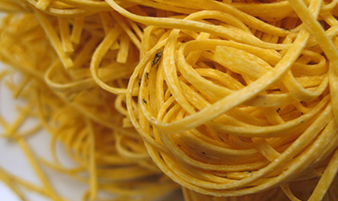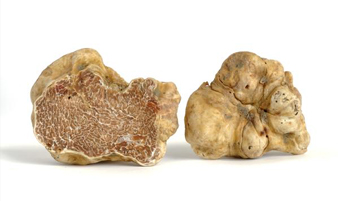Piedmont - A gourmet guide
Italian cuisine and produce are legendary. Famous the world over, and famously influenced by cultures from all over the world, Italian food is at its best in its culinary capital of Piedmont.
To celebrate the release of the latest vintages of Barolo, Barbaresco, and the wines of Piedmont, Langton's is taking a gastronomic tour of the most significant produce from one of the world's greatest food and wine regions.
Bagna Càuda
Bagna Càuda is a traditional dish made from butter, garlic, olive oil, and anchovies, then served (and eaten) like a fondu. Vegetables are the vehicle for flavour here and the typical dipper is a cardoon, a celery-like vegetable but a crudités selection will work just as well.
Easy to make, eminently shareable and incredibly moreish…
This is a simple dish, originally a peasant food (like all the best food), and is now served as a traditional appetizer. Easy to make, eminently shareable and incredibly moreish, the easy scalability of this dish, as well as its broad appeal, makes it a go-to for any entertainer looking to create a taste of northern Italy for their guests.
Pasta - Tajarin

To foodies, gourmands, and Italophiles, the idea of Italian regions having their own types of pasta will not be new. Tajarin (known outside of Piedmont as taglierini or tagliolini) is a long, thin pasta made with semolina and lots of eggs.
An intense yellow, tajarin’s colour is often emphasised by preparing it in butter. The high level of protein in tajarin (from the eggs) is no mistake; the wines of Piedmont are famously tannic. Best food friends, tannin and protein bind together soften the former and aid the breakdown and digestion of the latter. When pairing wines with food, tannin plays just as important a role as flavour when it comes to dishes at the more substantial end of the menu.
White truffles
We’ve talked tajarin so we must talk truffles. The one-two punch that is tajarin di tartufi is a regional favourite that’s world famous. This dish is made with tajarin pasta, butter and freshly shaved Tartufi Bianco di Alba — Albanese white truffles.

If your palate is not acquainted with these local Piedmontese white truffles, it ranks highly on the global bucket list of taste. Descriptions of white truffles usually fall inadequately back on earthy, musky, garlicky because white truffles taste like white truffles and nothing else. Harvested in October and November, they are far more rare than black truffles and increasingly so due to the decrease in numbers of the special truffle pig responsible for foraging. The harvest of these golden gastronomic nuggets is worthy of its own festival.
The Alba White Truffle Fair is held in October (2017 is its 87th year) and its excitement is only matched by its importance. As a culinary commodity, the volume at harvest time has an impact on fine dining restaurants around the world. Menus at some restaurants offer white truffle supplements at an additional cost and this is for two reasons; the first being the astronomical cost, and the second being that white truffles are an acquired taste.
Hazelnuts & chocolate
Piedmont produces hazelnuts in abundance and torta di nocciola, a cake made from egg white and hazelnut meal, is a traditional favourite. But it’s another hazelnut product that is famous throughout the world, Gianduja.
Originally a character in the Commedia dell'arte, Gian d’la duja represented the city of Turin and the region of Piedmont, particularly the abundance of the region, and would dole out individually wrapped treats. Today, Gianduja is the name of a mixture of hazelnut, cocoa, and cream made into the Gianduiotti chocolates and a famous chocolate spread – it is the home of Nutella and Ferrero Rocher.
Gianduja is the name of a mixture of hazelnut, cocoa, and cream…
Turin is one of the great chocolate cities of the world. Local chocolatiers make their own specialties from fiercely guarded secret recipes to the flamboyant chocolate sculptures. For chocolate lovers, Turin offers an endless arraying of new finds. It simply must be experienced.
Barolo & Barbaresco
This is Langton’s, so we’re going to have something to say about wine. And the wine. Oh, the wine. Barolo, Barbaresco and the wines of Piedmont are, for the initiated, eye-rollingly delicious. Often described in brief as tar and roses, there is so much depth, so many layers, such richness and delicacy and, like the local white truffles, are best described through the nose and palate.
We’ve selected two wines, a Barolo and a Barbaresco from what is one of the best Piedmontese portfolios Langton’s has to date. The traditional description and demarcations of the wines from these regions have less relevance today. Like many wines in Italy, complication is the cost of entry but it is a price worth paying.
…so much depth, so many layers, such richness and delicacy…
Barolo vs Barbaresco, traditional vs modern, vintage vs vintage. The truth is that these days the lines have blurred. The traditionalists have adopted some contemporary methods to make cleaner wines, the revolutionary winemakers honour tradition through their innovations. Barolo and Barbaresco are regions that are mature, prestigious yet evolving in a direction that leads to winemakers appealing to a specific palate. The wines from the region require extensive exploration and that begins here.